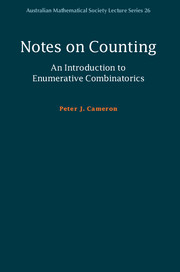Book contents
- Frontmatter
- Contents
- Preface
- 1 Introduction
- 2 Formal power series
- 3 Subsets, partitions and permutations
- 4 Recurrence relations
- 5 The permanent
- 6 q-analogues
- 7 Group actions and the cycle index
- 8 Möbius inversion
- 9 The Tutte polynomial
- 10 Species
- 11 Analytic methods: a first look
- 12 Further topics
- 13 Bibliography and further directions
- Index
- References
13 - Bibliography and further directions
Published online by Cambridge University Press: 28 June 2017
- Frontmatter
- Contents
- Preface
- 1 Introduction
- 2 Formal power series
- 3 Subsets, partitions and permutations
- 4 Recurrence relations
- 5 The permanent
- 6 q-analogues
- 7 Group actions and the cycle index
- 8 Möbius inversion
- 9 The Tutte polynomial
- 10 Species
- 11 Analytic methods: a first look
- 12 Further topics
- 13 Bibliography and further directions
- Index
- References
Summary
In this chapter I list a few books, papers and websites which may be useful if you would like to follow up some of the things I have discussed.
The On-line Encyclopedia of Integer Sequences
The On-line Encyclopedia of Integer Sequences, available at the URL https://oeis.org/,
is an essential resource for anyone doing research in combinatorics. For example, suppose you are trying to count the number of arrangements of n zeros and ones around a circle in which no two ones are consecutive (Exercise 2.8(b)). You might reasonably assume that n ≥ 3, and calculate that for n = 3,4,5 there are respectively 4, 7 and 11 such arrangements. If you type these three numbers into the Encyclopedia, you find many matches (I found 521 when I tried it on 24 October 2016), but near the top (indeed, at the top when I did the experiment) is an entry for the Lucas numbers. The entry gives a recurrence relation (identical to that for Fibonacci numbers), congruences modulo primes, representation in terms of hyperbolic functions, and much more, including (most importantly) ten references to the literature, short programs for computing the numbers in various programming languages, further web links, open problems, and cross-references to related sequences. Now you can either prove directly that the numbers you are interested in satisfy the Fibonacci recurrence (and hence coincide with the Lucas numbers), or check in the literature for further information which will help you make the identification.
On the Encyclopedia's website, you will find different ways of viewing the sequence and information about it, pointers to interesting or mysterious sequences,
a formula for the terms of the sequence or its generating function if known, and several articles by the editor Neil Sloane and others describing uses of the Encyclopedia in research. I have used it myself on a number of occasions.
- Type
- Chapter
- Information
- Notes on Counting: An Introduction to Enumerative Combinatorics , pp. 212 - 216Publisher: Cambridge University PressPrint publication year: 2017

